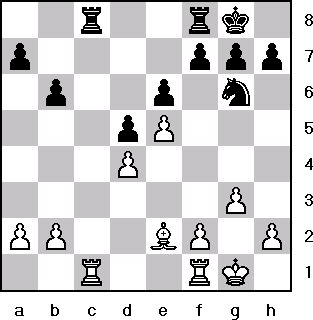|
Lesson
#8
Why Trade?
As we journey through the black and white jungle of the 64 squares we face
many questions. Which route should we take? Should we go along the less-traveled
mountain path? Or should we try to stay on the seemingly safer main path through
the jungle? Our first thoughts are often for safety, for simplifying the game,
for trading chess pieces.
But why trade? Exchanging pieces is not like trading marbles or baseball
cards. When you trade chess pieces they are gone, finished, done for. They canít
come back until the next game or the miracle of pawn promotion.
|
|
 |
White to move
|
Letís look at the example on the right. Whiteís game is at least equal.
He can trade rooks. As a matter of fact, many novices would play 1. Rxc8 here.
But what does that achieve? After
black retakes with 1. Ö Rxc8, he controls the open c-file and the game. You
need a good reason to trade. The fun of chopping wood is not a good enough
reason. Very often, and in this case, he who takes first loses a move. So, why
not try to make your opponent trade instead?
Do you see a great move for white? Yes, 1. Ba6 puts the question to
the black rook. If the black rook runs away, we invade on the 7th rank. And,
after 1.Ö Rxc1 2. Rxc1, white controls the c-file and will soon put his
rook on the 7th rank. This is what could happen next, 2.Ö Ra8 3. Rc7 Kf8 4.
Kf1 Ne7 5. Ke2 and after 5.ÖKe8 (trying to chase the rook off c7) 6.
Bb5+ Kf8 (not 6Ö Kd8 7. Rd7+ wins a piece) 7. Bd7 and black is
getting squeezed.
|
|
 |
White to move
|
Now, you decide if you should trade queens in the position below (the
answer is at the end of the article).
You might ask, "So when is it good to trade?" Well, Iíve
borrowed some guidelines from Aron Nimzowitschís classic "My
System" (which I highly recommend to any aspiring player with a rating
over 1200). Itís usually good for the attacking player to trade if:
- You can gain time by trading. For example, after 1. e4 d5 2. exd5 is
good because we can gain time after 2Ö. Qxd5 3. Nc3.
- Exchanging pieces is good when you are ahead in material because each
exchange brings you closer to a winning endgame.
- Often, an attack is strengthened by removing your opponents best
defender.
- Itís often good to get a bishop for a knight in open positions,
especially when you can keep the two bishops.
And here are some good trades if you are defending:
- You simply need to relieve the pressure.
- If your game is cramped and your pieces donít have enough room, you
are well advised to trade a few pieces and leave more room for the others.
- By all means trade your opponents best attacking piece.
- When you are down material then trade pawns (not pieces). Endgames are
harder to win with fewer pawns.
Remember, donít trade until you have a very good reason! Donít just
follow your first impulse. Be brave and go deeper into the uncharted jungle.
Also, it is usually better to force your opponent to start the trades. Find
another developing move. Gain space. Protect a weakness. Add pressure. Be a
lion in your chess jungle.
Answer: Trading queens for white loses a move and lets the black knight
into the game. After 1. Qxc5 Nxc5 2. Rxd6 fxg4 black is ok. Best is 1. g5! This
fixes blackís weak f5 pawn and we can win the d-pawn later.
Home Page ∑
More Lessons
(c) 2001 Ross Stoutenborough
|